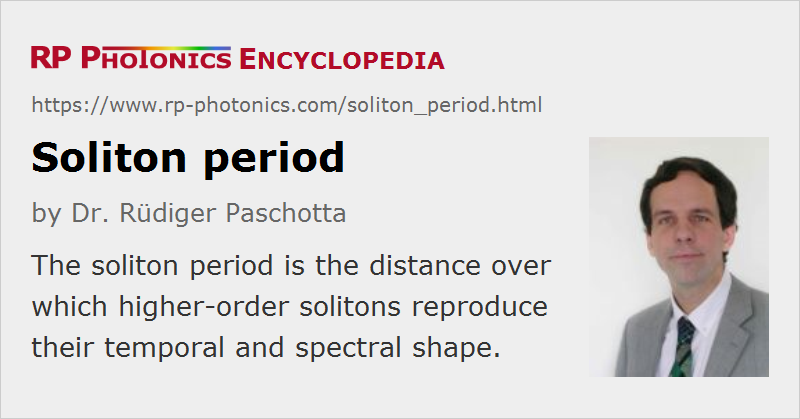Soliton Period
Definition: the distance over which higher-order solitons reproduce their temporal and spectral shape
German: Solitonenperiode
Categories: nonlinear optics, light pulses
Formula symbol: zs
Units: m
How to cite the article; suggest additional literature
Author: Dr. Rüdiger Paschotta
The soliton period is defined as the period with which higher-order soliton pulses evolve: after that propagation distance, they reproduce their original temporal and spectral shape.
The soliton period can be calculated according to

where τp is the pulse duration (full width at half-maximum, FWHM) and β2 is the group delay dispersion of the fiber (in s2/m).
Although fundamental solitons do not exhibit a periodic behavior, their soliton period is often calculated, because it is related to the propagation distance over which nonlinear phase shifts become substantial. We can use the fundamental soliton equation

in order to rewrite the equation for the soliton period of a fundamental soliton to
This shows that the nonlinear phase shift for the peak of that pulse in a non-dispersive fiber would be π / 2. The influence of chromatic dispersion is to obtain only a π / 4 phase shift, but this for the whole soliton pulse and not only for its peak.
In situations where solitons are periodically disturbed (e.g. in a soliton mode-locked laser or in an amplified optical fiber communications system), the effect of these disturbances depends strongly on the ratio of the period of the disturbances to the soliton period. If this ratio is well below unity (as is often the case in lasers), the solitons essentially experience just the average values of chromatic dispersion and Kerr nonlinearity, but for larger values of this ratio solitons can become unstable.
Questions and Comments from Users
Here you can submit questions and comments. As far as they get accepted by the author, they will appear above this paragraph together with the author’s answer. The author will decide on acceptance based on certain criteria. Essentially, the issue must be of sufficiently broad interest.
Please do not enter personal data here; we would otherwise delete it soon. (See also our privacy declaration.) If you wish to receive personal feedback or consultancy from the author, please contact him e.g. via e-mail.
By submitting the information, you give your consent to the potential publication of your inputs on our website according to our rules. (If you later retract your consent, we will delete those inputs.) As your inputs are first reviewed by the author, they may be published with some delay.
See also: solitons, higher-order solitons, adiabatic soliton compression
and other articles in the categories nonlinear optics, light pulses
 |





If you like this page, please share the link with your friends and colleagues, e.g. via social media:
These sharing buttons are implemented in a privacy-friendly way!